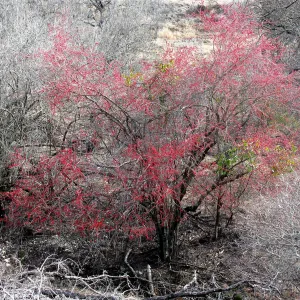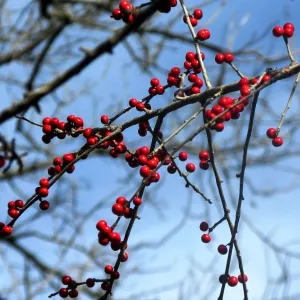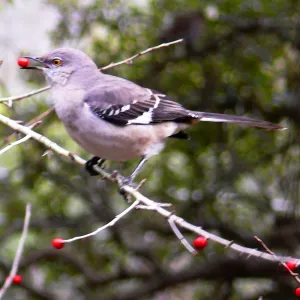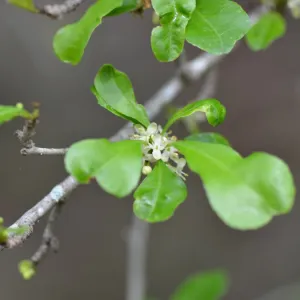By Bill Ward and a few lines by Delmar Cain, Boerne Chapter, Native Plant Society of Texas
Published in the Boerne Star on December 20, 2013.
Those stars of the winter months in the Hill Country are beginning to shine more brightly. No I am not talking about the “stars at night, that burn so bright.” I mean the ones that are growing along the fence rows and catch your eye with their bright red berries. In October 2010 Bill Ward wrote about the possumhaw holly, because it was the NICE Plant of the month for November and December of that year. Let’s revisit that column and reminisce on what a good writer and photographer he was.
“My wife knows how I complain that so many merchants rush the Christmas season, but here I am at Halloween time about to allude to Christmas time. However, our Operation NICE! Plant of the Month for November-December reminds me of the winter holidays.
“Deck the halls with boughs of possumhaw, tra la….” Yes, possumhaw (Ilex decidua)! This is the native holly of the Boerne area.

Also known as deciduous holly, this shrub or small tree is a true holly, but one that loses its leaves in the winter. The leafless limbs of the female possumhaw, however, may be covered with hundreds of small orange to red berries during the cold months. In many places, possumhaws are the only bright spots in a winter landscape.
Female (berry-producing) possumhaw is a popular landscape plant in this area, and it is readily available in local nurseries. In some places it is sold as “deciduous yaupon.” The evergreen yaupon (Ilex vomitoria), more typical of southeastern Texas, also can be cultivated in this part of the Hill Country, but may require more water than our locally native possumhaw, and it is less cold-tolerant than possumhaw.
We are lucky to have a few possumhaws native to our yard, and the larger ones are females, with showy red berries during the late fall. The berries on the big possumhaw nearest our house stay on the branches until mid winter, when a mockingbird takes charge of the tree and begins to methodically eat every berry. Cardinals and other berry-eating birds can join in the feast only when the mockingbird is away for a few minutes. The berries are said to be somewhat poisonous to humans, but they surely don’t hurt mockingbirds.

From time to time I meet people who tell me that one needs to grow both a male and a female possumhaw if the female plant is to produce the bright fruit. Indeed, the “Manual of Vascular Plants of Texas” by Correll and Johnston says Ilex has pistillate flowers (only female parts functional) and staminate flowers (only male parts functional) on separate plants. This puzzles me, because most possumhaws sold in nurseries are berry-producing plants, probably grown from cuttings. The result is that many local yards have only female possumhaws, and these plants put on berries every year, even though there is not a male plant in sight. Are there male possumhaws somewhere out there supplying pollen for long-distance fertilization of all these female flowers?
Possumhaw grows in the wild from the eastern and southern Texas Hill Country to Florida and north to Virginia and Illinois. Undoubtedly the species can tolerate a variety of soil types and moisture conditions. In this part of Texas, possumhaw grows in full sun in fence rows and also in understory shade along streams and ravines. It can be a very drought-tolerant landscape plant. Once established, most possumhaws will seldom, if ever, need irrigation.

The Boerne Chapter of the Native Plant Society of Texas provides free planting and care instructions for possumhaw at nurseries participating in Operation NICE! (Hill Country African Violets and Nursery, Maldonado Landscape and Nursery, and Medina Garden Nursery) as well as at the Cibolo Nature Center.

Landscape designer Sally Wasowski writes, “I use possumhaw a lot because it’s so versatile. It’s also one of the best trees (native or otherwise) when it comes to winter color” (“Texas Native Plants, Landscaping Region by Region”).
Another well-known Texas landscape designer, Jill Nokes (“How to Grow Native Plants of Texas and the Southwest”), writes that “if allowed to express its own nature, a grove of possumhaws against the edge of the woods or at the back of the property is truly wonderful.”
The only thing that I want to add is that the possumhaw also blooms nicely in the spring. Maybe Santa will bring one for your yard.
Happy Holidays.
